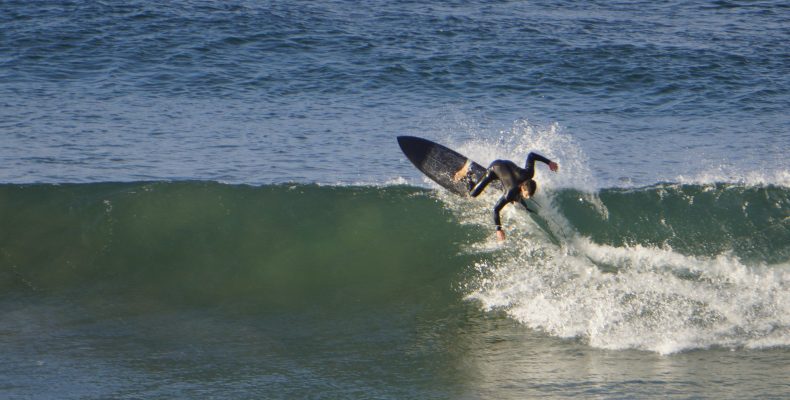New cluster member JUC SURF’s expertise in aerospace engineering and chemistry is shaking up the surfing world and offering carbon fibre manufacturers an environmentally-friendly solution for their waste material.
Producing the world’s first surfboards made from scrap carbon fibre, the innovative start up has sold boards in Hawaii and is making headlines in Las Vegas, San Francisco and Philadelphia.
JUC SURF boards are stronger, lighter and more durable than conventional e-glass fibre-reinforced boards, but cost around the same price.
“We have made boards before but they were just not eco-friendly like the new ones are,” says Dr Filip Stojcevski. “It seems this new series of recycled boards is has touched a nerve.”
“It is a huge issue in the industry and we started using it to make surfboards. We are just getting scrap rubbish and turning it into something better.”
– Dr Filip Stojcevski
Produced in bold black, the surfboards are in striking contrast to the idyllic blue waters of Victoria’s Great Ocean Road surfing mecca, which adjoins JUC SURF’s research at the Carbon Nexus facility in Waurn Ponds.
Dr Stojcevski, an aerospace engineer who is also a “beginner to intermediate” surfer, says the distinctive colour makes a visual splash.
“It is great seeing the only black boards on the beach. It is unique because every single surfboard you see is white, just the normal glass and foam. Ours just stands out so much and we love it because it is a conversation starter: ‘Why is your board that colour?’ It is awesome,” he says.
Three Deakin graduates, Dr Stojcevski and soon-to-be PHD graduate Andreas Hendlmeier and organic chemist James Randall, set up JUC SURF with the help of Deakin University’s SPARK Deakin Accelerator 2020 program.
The revolutionary surfboards utilise carbon fibre material sourced from the likes of cluster member Carbon Revolution and LeMond that would otherwise go to landfill.
“There are other carbon fibre surfboards out there but they are not recycled,” says Mr Hendlmeier, who arrived from Germany three years ago. “It is certainly the very first recycled carbon fibre surfboard and at the same time using our chemistry approach which is also brand new.”
He explains that carbon fibre is an inert surface and doesn’t readily bond. The team figured out a way to change the chemistry so it adheres better to resin, and can be laminated.
“We change the chemistry specifically for surfboards to make it bond better than anything ever has.”
Production is underway with the help of top professional board shapers in Torquay. Once this prototype phase is completed in November, the first commercial line is expected to be launched across Australia using recycled and scrap material sourced from local suppliers, especially in Geelong.
The Australian surfboard industry accounts for almost a third of the global market, with 8.5 million surfboards.
“It is just lucky that we live right next to Australia’s biggest surfing community in Torquay. It is just a match made in heaven and we want to go big,” Dr Stojcevski says.
Mr Hendlmeier says the immediacy of the start up was also exciting.
“To implement something in automotive or aerospace, something new, takes just forever until everything gets approved. With the surfboards, we have pretty much put our knowledge in right away and it is kind of a test trial where you can actually use the knowledge and put it into something real,” he says.
When starting his Deakin PhD with Boeing R and T Aerospace, Dr Stojcevski never expected to be trawling eBay to buy material to make surfboards.
A visiting French PhD student, ostensibly wanting to hone research skills, changed all that.
“He was really just in Australia to go surfing. He was from Bordeaux, he just loved surfing,” says Dr Stojcevski, who had the 19-year old conduct background research on carbon fibre and the chemistry required to make a surfboard.
“I was paying out of my own pocket and within about a week he had become friends with every shaper in town and came up with all these ideas and that is how we made our first surfboard,” Dr Stojcevski says. “We started this company completely on the side if I am honest.”
“The Deakin community has been very supportive. We are just really appreciative of it,” he adds.
Surfers have found carbon fibre too stiff in the past as manufacturers have not nailed the weaving density and orientation of the carbon fibre. JUC SURF’s advanced electrochemistry solves the problem.
“There is a reason carbon fibre surfboards have not become industry standard,” says Dr Stojcevski. “We are the first ever company to create a fabric that feels like a normal surfboard that professionals are used to that has the strength properties of carbon fibre board.”
The trio built a loom and take the scrap carbon fibre and “create a weave out of rubbish” to create fabric for the boards. Sometimes they cut shapes for reuse, depending on the scraps sourced.
“Using the knowledge that we have in aerospace and chemistry, we are the most technically minded surfboarders in the world. We have found an industry where we can finally stretch our legs and prove how good we are at carbon fibre,” Dr Stojcevski says.
More than 45,000 tonnes of carbon fibre goes into landfill each year and the trio is keen to hear from other cluster members with excess carbon fibre so they can consider if it is usable for a second application.
“We are excited to be involved with a group of high-quality industries. We are so eager to learn so much from them and if we could help them address the waste issue we would love that,” Dr Stojcevski says.
“If there are any surfers in the group, let us know!,” he adds.
Aug 2020
